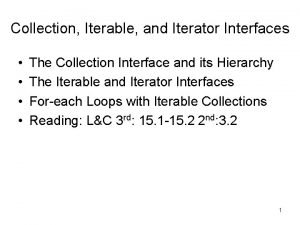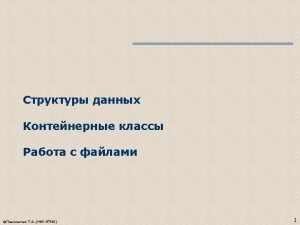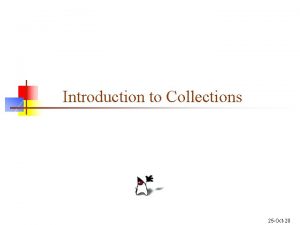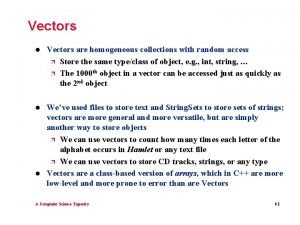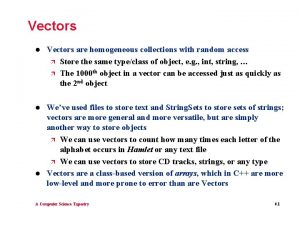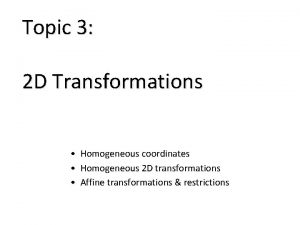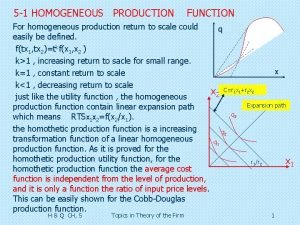Vectors l Vectors are homogeneous collections with random






















![Insert into sorted vector void insert(tvector<string>& a, const string& s) // pre: a[0] <= Insert into sorted vector void insert(tvector<string>& a, const string& s) // pre: a[0] <=](https://slidetodoc.com/presentation_image_h2/447b2f33f9d9bfc6d7ecafa19c202f5c/image-23.jpg)
![What about deletion? void remove(tvector<string>& a, int pos) // post: original a[pos] removed, size What about deletion? void remove(tvector<string>& a, int pos) // post: original a[pos] removed, size](https://slidetodoc.com/presentation_image_h2/447b2f33f9d9bfc6d7ecafa19c202f5c/image-24.jpg)
- Slides: 24

Vectors l Vectors are homogeneous collections with random access Ø Store the same type/class of object, e. g. , int, string, … Ø The 1000 th object in a vector can be accessed just as quickly as the 2 nd object l We’ve used files to store text and String. Sets to store sets of strings; vectors are more general and more versatile, but are simply another way to store objects Ø We can use vectors to count how many times each letter of the alphabet occurs in Hamlet or any text file Ø We can use vectors to store CD tracks, strings, or any type Vectors are a class-based version of arrays, which in C++ are more low-level and more prone to error than are Vectors l A Computer Science Tapestry 8. 1

Vector basics l We’re using the class tvector, need #include”tvector. h” Ø Based on the standard C++ (STL) class vector, but safe Ø Safe means programming errors are caught rather than ignored: sacrifice some speed for correctness Ø In general correct is better than fast, programming plan: • Make it run • Make it right • Make it fast l Vectors are typed, when defined must specify the type being stored, vectors are indexable, get the 1 st, 3 rd, or 105 th element tvector<int> ivals(10); // store 10 ints vals[0] = 3; tvector<string> svals(20); // store 20 strings svals[0] = “applesauce”; A Computer Science Tapestry 8. 2

Tracking Dice, see dieroll 2. cpp const int DICE_SIDES = 4; Roll 1 and 2 int main() { Roll 2 and 3 int k, sum; Dice d(DICE_SIDES); tvector<int> dice. Stats(2*DICE_SIDES+1); int roll. Count = Prompt. Range("how many rolls", 1, 20000); } for(k=2; k <= 2*DICE_SIDES; k++) dice. Stats { dice. Stats[k] = 0; 0 0 1 0 0 0 } for(k=0; k < roll. Count; k++) 0 1 2 3 4 5 6 7 8 { sum = d. Roll() + d. Roll(); dice. Stats[sum]++; } cout << "rolltt# of occurrences" << endl; for(k=2; k <= 2*DICE_SIDES; k++) { cout << k << "tt" << dice. Stats[k] << endl; } return 0; A Computer Science Tapestry 8. 3

Defining tvector objects l Can specify # elements in a vector, optionally an initial value tvector<int> values(300); // tvector<int> nums(200, 0); // tvector<double> d(10, 3. 14); // tvector<string> w(10, "foo"); // tvector<string> words(10); // l 300 ints, values ? ? 200 ints, all zero 10 doubles, all pi 10 strings, "foo" 10 words, all "" The class tvector stores objects with a default constructor Ø Cannot define tvector<Dice> cubes(10); since Dice doesn’t have default constructor Ø Standard class vector relaxes this requirement if vector uses push_back, tvector requires default constructor A Computer Science Tapestry 8. 4

Reading words into a vector tvector<string> words; string w; string filename = Prompt. String("enter file name: "); ifstream input(filename. c_str()); while (input >> w) { words. push_back(w); } cout << "read " << words. size() << " words" << endl; cout << "last word read is " << words[words. size() - 1] << endl; l What header files are needed? What happens with Hamlet? Where does push_back() put a string? A Computer Science Tapestry 8. 5

Using tvector: : push_back l The method push_back adds new objects to the “end” of a vector, creating new space when needed Ø The vector must be defined initially without specifying a size Ø Internally, the vector keeps track of its capacity, and when capacity is reached, the vector “grows” Ø A vector grows by copying old list into a new list twice as big, then throwing out the old list l The capacity of a vector doubles when it’s reached: 0, 2, 4, 8, 16, 32, … Ø How much storage used/wasted when capacity is 1024? Ø Is this a problem? A Computer Science Tapestry 8. 6

Comparing size() and capacity() l When a vector is defined with no initial capacity, and push_back is used to add elements, size() returns the number of elements actually in the vector Ø This is the number of calls of push_back() if no elements are deleted Ø If elements deleted using pop_back(), size updated too l The capacity of vector is accessible using tvector: : capacity(), clients don’t often need this value Ø An initial capacity can be specified using reserve() if client programs know the vector will resize itself often Ø The function resize() grows a vector, but not used in conjunction with size() – clients must track # objects in vector separately rather than vector tracking itself A Computer Science Tapestry 8. 7

Passing vectors as parameters l Vectors can be passed as parameters to functions Ø Pass by reference or const reference (if no changes made) Ø Passing by value makes a copy, requires time and space void Read. Words(istream& input, tvector<string>& v); // post: v contains all strings in input, // v. size() == # of strings read and stored void Print(const tvector<string>& v) // pre: v. size() == # elements in v // post: elements of v printed to cout, one per line l If tvector: : size() is not used, functions often require an int parameter indicating # elements in vector A Computer Science Tapestry 8. 8

Vectors as data members l A tvector can be a (private) instance variable in a class Ø Constructed/initialized in class constructor Ø If size given, must be specified in initializer list class Word. Store { public: Word. Store(); private: tvector<string> my. Words; }; Word. Store: : Word. Store() : my. Words(20) { } Ø What if push_back() used? What if reserve() used? A Computer Science Tapestry 8. 9

Vectors as data members (continued) l It’s not possible to specify a size in the class declaration Ø Declaration is what an object looks like, no code involved Ø Size specified in constructor, implementation. cpp file class Word. Store { private: tvector<string> my. Words(20); }; l // NOT LEGAL SYNTAX! If push_back is used, explicit construction not required, but ok Word. Store: : Word. Store() : my. Words() // default, zero-element constructor { } Ø No ()’s for local variable: tvector<string> words; A Computer Science Tapestry 8. 10

Searching a vector l We can search for one occurrence, return true/false or index Ø Sequential search, every element examined Ø Are there alternatives? Are there reasons to explore these? l We can search for number of occurrences, count “the” in a vector of words, count jazz CDs in a CD collection Ø Search entire vector, increment a counter Ø Similar to one occurrence search, differences? l We can search for many occurrences, but return occurrences rather than count Ø Find jazz CDs, return a vector of CDs A Computer Science Tapestry 8. 11

Counting search void count(tvector<string>& a, const string& s) // pre: number of elements in a is a. size() // post: returns # occurrences of s in a { int count = 0; int k; for(k=0; k < a. size(); k++) { if (a[k] == s) { count++; } } return count; } l How does this change for true/false single occurrence search? A Computer Science Tapestry 8. 12

Collecting search void collect(tvector<string>& a, const string& s, tvector<string>& matches) // pre: number of elements in a is a. size() // post: matches contains all elements of a with // same first letter as s { int k; matches. clear(); // size is zero, capacity? for(k=0; k < a. size(); k++) { if (a[k]. substr(1, 0) == s. substr(1, 0)) { matches. push_back(a[k]); } } } l What does clear() do, similar to resize(0)? A Computer Science Tapestry 8. 13

Algorithms for searching l If we do lots of searching, we can do better than sequential search aka linear search where we look at all vector elements Ø Why might we want to do better? Ø Analogy to “guess a number” between 1 and 100, with response of high, low, or correct l In guess-a-number, how many guesses needed to guess a number between 1 and 1, 000? Why? Ø How do you reason about this? Ø Start from similar, but smaller/simpler example Ø What about looking up word in dictionary, number in phone book given a name? Ø What about looking up name for given number? A Computer Science Tapestry 8. 14

Binary search l If a vector is sorted we can use the sorted property to eliminate half the vector elements with one comparison using < Ø What number do we guess first in 1. . 100 game? Ø What page do we turn to first in the dictionary? l Idea of creating program to do binary search Ø Consider range of entries search key could be in, eliminate half the entries if the middle element isn’t the key Ø How do we know when we’re done? Ø Is this harder to get right than sequential search? A Computer Science Tapestry 8. 15

Binary search code, is it correct? int bsearch(const tvector<string>& list, const string& key) // pre: list. size() == # elements in list, list is sorted // post: returns index of key in list, -1 if key not found { int low = 0; // leftmost possible entry int high = list. size()-1; // rightmost possible entry int mid; // middle of current range while (low <= high) { mid = (low + high)/2; if (list[mid] == key) // found key, exit search { return mid; } else if (list[mid] < key) // key in upper half { low = mid + 1; } else // key in lower half { high = mid - 1; } } return -1; // not in list } A Computer Science Tapestry 8. 16

Binary and Sequential Search: Better? l Number of comparisons needed to search 1 billion elements? Ø Sequential search uses ____ comparisons? Ø Binary search uses ____ comparisons Ø Which is better? What’s a prerequisite for binary search? l See timesearch. cpp for comparison of lots of searching Ø Is it worth using binary search? Ø Binary search is the best comparison-based search!! l What about Google and other search engines? Ø Is binary search fast enough? How many hits per query? Ø What alternatives are there? A Computer Science Tapestry 8. 17

Picking a word at random l Suppose you want to choose one of several words at random, e. g. , for playing a game like Hangman Ø Read words into a vector, pick a random string from the vector by using a Rand. Gen or Dice object. Drawbacks? Ø l Read words, shuffle the words in the vector, return starting from front. Drawbacks? Steps: read words into vector, shuffle, return one-at-a-time Ø Alternatives: use a class, read is one method, pick at random is another method Ø Don’t use a class, test program with all code in main, for example A Computer Science Tapestry 8. 18

First approach, pick a word at random tvector<string> words; string w, filename = “words. txt”; Rand. Gen gen; ifstream input(filename. c_str()); while (input >> w) { words. push_back(w); } for(k=0; k < words. size(); k++) { int index = gen. Rand. Int(0, words. size()-1); cout << words[index] << endl; } l What could happen in the for-loop? Is this desired behavior? A Computer Science Tapestry 8. 19

Shuffling the words (shuffle. cpp) tvector<string> words; string w, filename = “words. txt”; Rand. Gen gen; ifstream input(filename. c_str()); while (input >> w) { words. push_back(w); } // note: loop goes to one less than vector size for(k=0; k < words. size()-1; k++) { int index = gen. Rand. Int(k, words. size()-1); string temp = words[k]; words[k] = words[index]; words[index] = temp; } // Print all elements of vector here l Key ideas: swapping elements, choosing element “at random” Ø All arrangements/permuations equally likely A Computer Science Tapestry 8. 20

Why this is a good shuffling technique l Suppose you have a CD with 5 tracks, or a vector of 5 words Ø The first track stays where it is one-fifth of the time, that’s good, since 1/5 of all permutations have track one first Ø If the first track is swapped out (4/5 of the time) it will then end up in the second position with probability 1/4, that’s 4/5 x 1/4 = 1/5 of the time, which is what we want Ø Also note five choices for first entry, # arrangements is 5 x 4 x 3 x 2 x 1 = 5! Which is what we want. l One alternative, make 5 passes, with each pass choose any of the five tracks/words for each position Ø Number of arrangements is 5 x 5 x 5 > 5!, not desired, there must be some “repeat” arrangements A Computer Science Tapestry 8. 21

Vector idioms: insertion and deletion l It’s easy to insert at the end of a vector, use push_back() Ø Ø We may want to keep the vector sorted, then we can’t just add to the end Why might we keep a vector sorted? l If we need to delete an element from a vector, how can we “closeup” the hole created by the deletion? Ø Store the last element in the deleted spot, decrease size Ø Shift all elements left by one index, decrease size l In both cases we decrease size, this is done using pop_back() Ø Analagous to push_back(), changes size, not capacity A Computer Science Tapestry 8. 22
![Insert into sorted vector void inserttvectorstring a const string s pre a0 Insert into sorted vector void insert(tvector<string>& a, const string& s) // pre: a[0] <=](https://slidetodoc.com/presentation_image_h2/447b2f33f9d9bfc6d7ecafa19c202f5c/image-23.jpg)
Insert into sorted vector void insert(tvector<string>& a, const string& s) // pre: a[0] <= … <= a[a. size()-1], a is sorted // post: s inserted into a, a still sorted { int count = a. size(); // size before insertion a. push_back(s); // increase size int loc = count; // insert here? // invariant: for k in [loc+1. . count], s < a[k] } l while (0 <= loc && s < a[loc-1]) { a[loc] = a[loc-1]; loc--; } a[loc] = s; What if s belongs last? Or first? Or in the middle? A Computer Science Tapestry 8. 23
![What about deletion void removetvectorstring a int pos post original apos removed size What about deletion? void remove(tvector<string>& a, int pos) // post: original a[pos] removed, size](https://slidetodoc.com/presentation_image_h2/447b2f33f9d9bfc6d7ecafa19c202f5c/image-24.jpg)
What about deletion? void remove(tvector<string>& a, int pos) // post: original a[pos] removed, size decreased { int last. Index = a. size()-1; a[pos] = a[last. Index]; a. pop_back(); } l How do we find index of item to be deleted? What about if vector is sorted, what changes? l What’s the purpose of the pop_back() call? l A Computer Science Tapestry 8. 24
 Antigentest åre
Antigentest åre Definition of homogeneous differential equation
Definition of homogeneous differential equation Random assignment vs random sampling
Random assignment vs random sampling Random assignment vs random selection
Random assignment vs random selection Using system using system.collections.generic
Using system using system.collections.generic Benchmarks in collections care
Benchmarks in collections care Set interface in java
Set interface in java Bio dig
Bio dig Ucla special collections
Ucla special collections Financial data systems collections
Financial data systems collections Hltpat001
Hltpat001 Revenue cycle sales to cash collections
Revenue cycle sales to cash collections Google guava collections
Google guava collections Eton college collections
Eton college collections System.collections.generic namespace
System.collections.generic namespace The process of classifying and reviewing past due accounts
The process of classifying and reviewing past due accounts Collection strategy in sap
Collection strategy in sap Pseg credit and collections
Pseg credit and collections Neuronal pools are collections of
Neuronal pools are collections of Customers typically pay according to each invoice with the
Customers typically pay according to each invoice with the Collections
Collections Aba therapy billing and insurance services
Aba therapy billing and insurance services Menu collections pane di windows movie maker berguna untuk
Menu collections pane di windows movie maker berguna untuk Largest galaxy
Largest galaxy Arm industry collections
Arm industry collections






